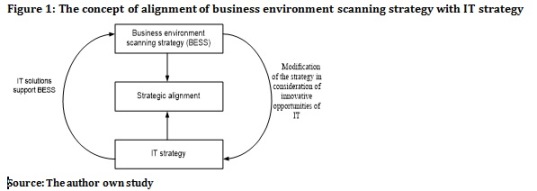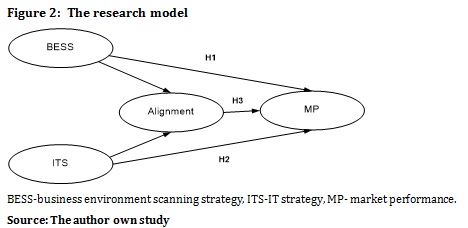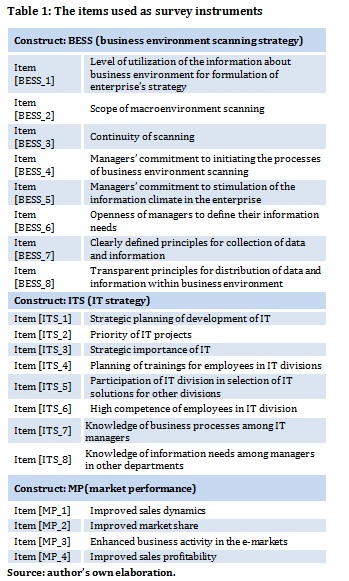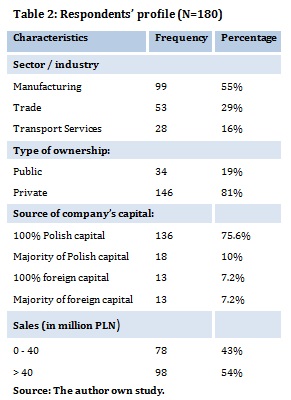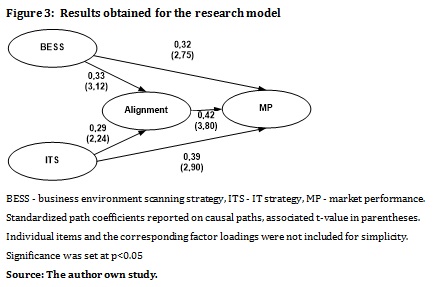Serviços Personalizados
Journal
Artigo
Indicadores
-
 Citado por SciELO
Citado por SciELO -
 Acessos
Acessos
Links relacionados
-
 Similares em
SciELO
Similares em
SciELO
Compartilhar
Tourism & Management Studies
versão impressa ISSN 2182-8458
TMStudies vol.9 no.1 Faro 2013
Synergistic effect in alignment between business environment scanning strategy and IT strategy in enterprises
Efeito sinérgico no alinhamento entre a estratégia da monitorização ambiental (environmental scanning) e a estratégia das tecnologias de informação (TI) nas empresas
Dorota Jelonek
Czestochowa University of Technology, Faculty of Management, jelonek@zim.pcz.pl
ABSTRACT
This paper aims to confirm the hypothesis of synergistic effect of alignment of business environment scanning strategy with IT strategy on market performance in large and medium-sized enterprises in Poland. A model of alignment of the strategies of business environment scanning and IT in the enterprises was used to verify the following hypothesis: “Alignment between business environment scanning strategy and IT strategy affects market performance in the enterprise more significantly compared to these strategies considered individually”.
The paper is divided into two parts. Firstly, it briefly reviews the literature regarding alignment, business environment scanning and IT. Secondly, a conceptual model of strategic alignment of business environment scanning strategy with IT strategy is presented and verified.
Keywords : Business environment scanning strategy, IT strategy, alignment, enterprise’s market performance, confirmatory factor analysis
RESUMO
Este trabalho tem como objetivo confirmar a hipótese de efeito sinérgico do alinhamento da estratégia de monitorização ambiental (environmental scanning) com a estratégia de TI no desempenho de mercado em grandes e médias empresas na Polónia. Um modelo de alinhamento das estratégias de monitorização ambiental e de TI nas empresas foi utilizado para verificar a seguinte hipótese: "O alinhamento entre a estratégia de monitorização ambiental e a estratégia de TI afeta o desempenho de mercado na empresa de forma mais significativa do que quando essas estratégias são consideradas individualmente".
O documento está dividido em duas partes. Em primeiro lugar, faz uma breve revisão da literatura sobre o alinhamento, a estratégia da monitorização ambiental e as TI. Em segundo lugar, é apresentado e verificado um modelo conceptual de alinhamento estratégico da monitorização ambiental com a estratégia de TI.
Palavras-chave: monitorização ambiental, estratégia de TI, alinhamento, desempenho do mercado da empresa, análise fatorial confirmatória.
1. Introduction
Synergy is the creation of a whole that is greater than the sum of its parts. In other words, synergy means the combined effect that influences different practical or experimental spheres. The synergistic effect is observed when the interaction of at least two factors affecting specific performance in a system produces the effect which is greater than the sum of the effects of individual factors that affect the system separately. It is remarkable that synergy might be even a profitable and desirable phenomenon if the positive factors are interacting with negative ones. The case might be that the interaction of the factor of negative effect with the factor of positive effect does not cause that the factors balance with each other but one of the factors magnifies the effect of the other and they consequently produce the value greater than the value obtained from summing the values with the opposite signs. Therefore, synergy occurs when the two factors, after coupling, have a stimulating effect on each other. The major focus of further investigations discussed in the present paper is on the synergistic effect which translates directly into improved market performance in enterprises. The study analyses the factors included in the model of alignment of business environment scanning strategy with IT solutions that support the environment scanning processes.
2. Literature review and research hypotheses
Numerous studies have emphasized new concepts in environmental scanning and acquisition of information about business environment. Depending on the extent of the environment to be monitored and analysed, the following methods can be used: competitor intelligence (Porter, 1996), business intelligence (Kwiecinski, 1999), environment monitoring (Jelonek, 2002).
Early studies of the problem of business environment scanning were only of descriptive nature and they did not focus on evaluation of changes. Although this trend emphasized changes in the environment, it entirely ignored the problem of how the managers are expected to deal with the new uncertain situation (Xu, Kaye & Duan, 2003). This is connected with the perception of the environment as a place to search for resources. Changes in the approach to business environment from ‘environment as a resource’ to ‘environment as a source of threats’ caused that business environment scanning shifted from passive and descriptive towards active and research-based. Research trends exhibited different activities toward exploring business environment, with particular focus on the investigations of unknown areas of business environment and, what is even more important, on analysis of the causes of changes that occurred (Brown & Weiner, 1985).
The information technology (IT) strategy is very often concerned with aligning IT development with business needs and with attempting to gain a strategic advantage through utilization of information systems and information technology in the enterprise. IT strategy involves information system (IS) and information technology components, where IS determines the enterprise’s requirements for information and systems to support the overall business strategy.
IT strategy is considered as a process of planning of development of systems according to a vision of the future role of information technology within the organization. IT strategy integrates business goals in the enterprise, clear understanding of managers’ knowledge to support these goals and implementation of the computer systems to collect and share this information. IS/IT strategy determines and prioritizes the investments required to achieve the ‘ideal’ applications portfolio, the nature of the benefits expected and the changes required to deliver those benefits, within the constraints of resources and systems interdependencies (Ward & Peppard, 2002).
Numerous synonyms for alignment have been used in literature. These include strategic alignment (Henderson & Venkatraman, 1993), fit (Porter, 1985), integration (Weil & Broadbent, 1998), and linkage (Reich & Benbasat, 1996). The essential feature of alignment is that “organizational performance is a consequence of fit between two or more factors such as the fit between organization environment, strategy, structure, system, style, and culture” (Van de Ven & Drazin, 1985).
The major trends of investigations can be observed in the related literature: conceptual definitions of alignment, operational definitions of alignment and measurement models and constructs of alignment.
The example of conceptual definition of alignment was formulated by Reich & Benbasat (1996). IS-Business alignment is defined as the degree to which the IT mission, objectives, and plans support and are supported by the business mission, objectives, and plans. In this definition, "objectives" refers to the goals and the strategies of an organizational unit.
The next example is Luftman’s (2000) definition: IS-Business alignment as applying IT in an appropriate and timely way in harmony with business strategies, goals and needs. It can be addressed by the two questions:
1. How IT is aligned with the business?
2. How the business should or could be aligned with IT?
Mature alignment evolves into a relationship where IT and other business functions adapt their strategies together.
According to Luftman (2000), the operational definition of IS-Business alignment is the actual implementation of the following processes:
1. Set the goals and establish a team,
2. Understand the business-IT linkage,
3. Analyze and prioritize gaps,
4. Specify the actions (project management),
5. Choose and evaluate success criteria,
6. Sustain alignment.
The primary objective of the assessment is to identify specific recommendations to improve the alignment of IT and the business. The evaluation team, after the assessment, uses the results to converge on an overall assessment level of the maturity for the firm. They apply the next higher level of maturity as a roadmap to identify what they should do next.
The third trend of scientific measurement is measurement models and constructs of alignment. The examples of the models of alignment and its constructs that have been developed and used in previous studies are:
· Strategic Alignment Maturity Assessment Model (Luftman, 2000), a model that is proposed to assess the maturity level of strategic IS-Business alignment in an organization. It provides a tool for the organization to check where it stands and how it can improve. It consists of five levels of strategic alignment maturity that focus on the six sets of alignment criteria: communications, competency/value, measurements, governance, partnership, scope & architecture, and skills.
· Conceptual Model of Maturity, Linkage and Performance (Sledgianowski & Luftman, 2001).
A conceptual model that links all the six factors in the Strategic Alignment Maturity Assessment Model with short-term linkage and organizational performance.
The literature contains a plethora of examples that confirm the significance of the alignment of business strategy and IT strategy (Henderson & Venkatraman, 1993) and investigations and studies concerning the alignment between Human Resource Management and Knowledge Management (Shih & Chiang, 2005) or alignment between virtual enterprise and IT (Cao & Dowlatshahi, 2005).
This paper presents a model of alignment of business environment scanning strategy with IT strategy and positive effect of the alignment on market performance in medium-sized and large Polish enterprises. Figure 1 presents the concept of alignment of business environment scanning strategy with IT strategy.
The following definition of strategic alignment was employed for further investigations: strategic alignment of business environment scanning and IT is a process, i.e. a coherent set of sequentially performed combined and interacting activities or actions while its goal is to achieve the expected results in the form of support from information technology for implementation of business environment scanning (IT-BES adjustment) and the situation where innovative opportunities for utilization of IT causes modification of the adopted strategies (BES-IT). The goal of the actions taken is to achieve the effects which positively impact on the results achieved by the enterprise. Therefore, alignment is a dynamic and continuous process (Jelonek, 2009).
3. Methodology
3.1. Research model
The research model proposed in the study and illustrated in Figure 2 is a schematic representation of the principal research question:Can enterprise enhance their market performance by aligning their business environment scanning strategy with information technology strategy?
The model of alignment of the strategy of business environment scanning and IT strategy in the enterprise will be used for verification of the hypotheses H1, H2, H3, H4.
H1: Business environment scanning strategy positively affects market performance.
H2: IT strategy positively affects market performance.
H3: Alignment between business environment scanning strategy and IT strategy positively affects market performance.
A corollary for H3 could be stated in the form of a new hypothesis:
H4: Alignment between business environment scanning strategy and IT strategy affects market performance in the enterprise more significantly compared to these strategies considered individually.
Because the variable „alignment” is hidden, confirmatory factor analysis will be used in order to assess its impact on market performance in the enterprise.
3.2. Variables
In this model, strategic alignment is an emergent construct, resulting from the covariation of the two constructs: business environment scanning strategy (BESS) and IT strategy (ITS). As a latent variable is considered as a second order factor resulting from a confirmatory factor analysis and any item is needed to measure this construct. Business environment scanning strategy (BESS), IT strategy (ITS) and market performance (MP) are considered as first order factors measured with reflective constructs (observed variables: the items of the questionnaire).
For the purpose of the study, the construct of BESS was created in a multidimensional perspective and eight criteria were chosen for measurement. BESS structure is the author’s own proposal, however, the studies by Choo (2001), Kourteli (2000) and Beal (2000) were used to support this concept. Furthermore, in order to model the BESS variable, the author used studies by Correia & Wilson (2001) who identified and analysed factors which are internal to the organization and affect the environmental scanning. These factors include individual factors and organizational factors such as information climate. BESS structure includes commitment of managers to initiation of scanning processes and their involvement in creation information climate in the enterprise.
Eight criteria were selected to measure IT strategy (ITS) in this model. The IT strategy is focused on outlining the vision of how the organization’s demand for information and systems will be supported by technology, where essentially, it is concerned with IT supply (Luftman, 2000; Luftman, Papp & Brier, 1996). The construct ITS was created based on literature models and the author’s own research. The basic IT strategy components were outlined by (Henderson & Venkatraman, 1993; Luftman 2000):
1. Technology scope: The important information applications and technologies.
2. Systemic competencies: The capabilities (e.g. access to information that is important to creation/achievement of business strategies) that distinguish IT services.
3. IT governance: How the authority for resources, risk, conflict resolution, and responsibility for IT is shared among business partners, IT management, and service providers. Project selection and prioritization issues are included here.
Four criteria to measure market performance (MP) adopted from (Seggie, Kim & Cavusgil, 2006) and (Venkatraman & Ramanujam, 1986) were used in this model. Market performance was defined by four observable variables. Evaluation of market performance in enterprises should provide the answer to the question of how well the enterprise achieves its market targets. The definition of market performance utilizes retail sales reached in a particular enterprise compared to this indicator evaluated for the whole sector. A particular market-related standing of the enterprise can be deduced from the enterprise’s market share. The enterprise’s market performance is affected by sales profitability with respect to other enterprises in the sector. It was also observed that the enterprises, facing the challenges of the era of dynamically developing electronic economies, should also strive for entering into the electronic markets. The improved business activity in the electronic markets can be achieved in a variety of ways, ranging from passive presence in the network and utilizing the opportunities opened up by the e-commerce to full transformation into new forms of business and virtual networks. The enterprises which strive for improvement in their market rating cannot overlook the progressive process of conversion of the traditional business environment into the e-environment and should meet the challenges of the digital economy. The items used as survey instruments are presented in Table 1.
3.3. Data collection
The goal of this study is to investigate the effect of alignment of environment scanning with IT strategies on business performance. A questionnaire survey was used to collect data for this study. The questionnaire was initially pre-tested among 10 senior executives. Modifications were made and the revised questionnaire was prepared for data collection. 20 questions were selected from the whole set.
A 5-point Likert-type scale was selected (from entirely disagree to entirely agree) for the business environment scanning strategy, IT strategy and market performance.
The survey was conducted by an enterprise which provides professional market survey services using Computer Assisted Telephone Interviewing (CATI) technique. A test group was selected randomly from medium-sized and large enterprises.
180 respondents were effectively interviewed. The respondents included senior managers and supervisors from the divisions closely related to the market, i.e. marketing, sales etc. Table 2 presents respondents’ profile.
4. Main results
The research sample included 180 respondents. Each of them answered 20 questions contained in the questionnaire that represented three constructs of variables. To confirm that each construct (BESS, ITS, MP) was measured accurately by the proposed items, the Exploratory Factor Analysis (EFA) method was initially used (to confirm the fit of the construct), and then the unidimensionality of the constructs was confirmed by means of the Confirmatory Factor Analysis (CFA).
The Kaiser-Meyer-Olkin measure (KMO) was 0.720 and was located in [0;1] interval. Value of Bartlett's Test of Sphericity was significant (Chi-square = 114.20; df=51; p=0.05). Therefore, the data set of this research was adequate for factor analysis. Eigenvalues for items were: BESS (5.361), ITS (3.232), MP (3.020). Reliability of all the constructs was tested with Cronbach-Alpha method. Cronbach-Alfa for all the items remained at the recommended level (0.700) and were: BESS (0.776), ITS (0.842), MP (0.780).
Table 3 presents the indices obtained for this model and compares them to the recommended indices and to the saturated model (where all the latent variables are interrelated).
The overall fit indices are good. Therefore, the research model presented in Figure 2 is plausible in the population. The alignment variable is significantly correlated with both independent variables of the model: busines environment scanning strategy and IT strategy.
The path from alignment to market performance is 0.42 (t=3.80). This means that higher levels of alignment lead to higher levels of market performance. The path from BESS to MP is 0.32 (t=2.75), and the path form ITS to MP is 0.39 (t=2.90). All t-values were significant at p<0.05. This indicated that all the hypotheses were verified at the construct level.
5. Conclusions
The findings of the present study lead to the conclusion that the process of strategic alignment of BESS and ITS is not a simple task. It requires that the owners and managers in the enterprises should be aware of many factors that might affect the strategic alignment. The results obtained in this study are likely to provide companies with a better understanding of how they can align their business environment scanning strategy to IT strategy, and provide the basis for further research into this important area of business.
The study confirmed that both BESS positively impacts on market performance (H1), and that ITS has also a positive effect on this performance (H2). However, the best results are likely to be achieved if BES and IT strategies are aligned (H3). The obtained values show that the effect of alignment of BESS with ITS on market performance in enterprises is higher than the sum of the effects of the individual components of this alignment. Therefore, it was demonstrated that the positive synergistic effect of alignment of BESS with ITS on market performance can be expected. Consequently, the results obtained confirm the hypothesis H4.
In the context of selection of a research sample for verification of the presented model (medium-sized and large companies) and positive verification of all the hypotheses (H1, H2, H3 and H4), the results from similar investigations concerning e.g. manufacturing companies should be also emphasized. In a model of strategic alignment (using all 52 variables) in manufacturing companies (99 business entities), a positive effect of strategic alignment on company performance was confirmed (hypothesis H3). However, the impact of IT on company performance was even higher and consequently hypothesis H4 was not confirmed (Jelonek, 2009).
As mentioned before, division of alignment of BES and IT into strategic and operational levels is a theoretical operation, but the results obtained in the investigations can be useful in the analysis of the following research problems in the future:
Does alignment of BES with IT at the operational level positively affect market performance achieved by medium-sized and large-sized companies?
Is it possible to expect the synergistic effect at the above operational level as a result of alignment?
Solving these research problems can provide a good base and a starting point for development of a set of good practices for achievement of strategic alignment of BESS with ITS in order for the enterprise to reach highest possible performance. However, an open problem remains for the future, concerning the assessment, measurement methods and the methods of improvement in strategic alignment.
References
Beal, R.M. (2000). Competing effectively: environmental scanning, competitive strategy, and organizational performance in small manufacturing firms. Journal of Small Business Management, 38(1), 27-47. [ Links ]
Brown, A., & Weiner, E. (1985). Super managing: How to harness change for personal and organizational success. New York: Mentor. [ Links ]
Cao, Q., & Dowlatshahi, S. (2005). The impact of alignment between virtual enterprise and information technology on business performance in an agile manufacturing environment. Journal of Operations Management, 23, 531-550. [ Links ]
Choo, Ch. W. (2001). Environmental scanning as information seeking and organizational learning. Information Research, 7(1). Retrieved from http://InformationR.net/ir/7-1/paper112.html. [ Links ]
Correia Z., & Wilson, T.D. (2001). Factors influencing environmental scanning in the organizational context. Information Research, 7(1). Retrieved from http://InformationR.net/ir/7-1/paper121.html. [ Links ]
Henderson, J.C., & Venkatraman, N. (1993). Strategic Alignment: Leveraging Information Technology for Transforming Organizations. IBM Systems Journal, 32(1), 4-16. [ Links ]
Jelonek, D. (2002). Business Environment Monitoring System. Czestochowa: School Press of Czestochowa University of Technology. [ Links ]
Jelonek, D. (2009). Strategic Alignment Between Environment Monitoring and Information Technology in a Company.
A Methodological and Empirical Study . Czestochowa: School Press of Czestochowa University of Technology.
Kefi, H., & Kalika, M. (2005). Survey of Strategic Alignment Impacts on Organizational Performance in International European Companies. Retrieved June 10, 2012, from http://www2.computer.org/portal/web/csdl/doi/10.1109/HICSS.2005.570. [ Links ]
Kourteli, L. (2000). Scanning the business environment: some conceptual issues. Benchmarking: An International Journal, 7(5), 406-413. [ Links ]
Kwiecinski, M. (1999). The Role of Business Intelligence in Management. Warszawa: Science Publishing House PWN. [ Links ]
Luftman, J. (2000). Assessing Business Alignment Maturity. Communications of the Association for Information Systems, 4, 1-50. [ Links ]
Luftman, J.N., Papp, R. & Brier, T. (1996). Business and IT in harmony: enablers and inhibitors to alignment. Retrieved June 10, 2012, from http://Hsb.Baylor.Edu/Ramsower/AIS.Ac.96/Papers/PAPP.htm. [ Links ]
Porter, M. E. (1996). Competitive Strategy: Techniques for Analysing Industries and Competitors. Warszawa: Economic Publishing House. [ Links ]
Porter, M. E. (1985). Competitive Advantage. New York: Free Press. [ Links ]
Reich, B. H., & Benbasat, I. (1996). Measuring the linkage between business and information technology objectives. MIS Quarterly, 20(1), 55-78. [ Links ]
Sagan, A. (2003). Model pomiarowy satysfakcji i lojalności. StatSoft Polska, 75-85. Retrieved from http://www.statsoft.pl/czytelnia/marketing/pomiarowy.pdf. [ Links ]
Seggie, S. H., Kim, D., & Cavusgil, S. T. (2006). Do supply chain IT alignment and supply chain interfirm system integration impact upon brand equity and firm performance? Journal of Businass Research, 59, 887-895. [ Links ]
Shih, H-A., & Chiang, Y-H. (2005). Strategy Alignment Between HRM, KM, and Corporate Development. International Journal of Manpower, 26(6), 582-603. [ Links ]
Sledgianowski, D., & Luftman, J. N. (2001). Assessing strategic alignment maturity and its effect on organizational performance and Mutual Understanding of Objectives. Proceedings of the 7th Americas Conference on Information Systems, 1729-1731. [ Links ]
Van De Ven, A., & Drazin, R. (1985). The Concept of Fit in Contingency Theory. Research in Organizational Behavior, 7, 333–365. [ Links ]
Venkatraman, N., & Ramanujam, V. (1986). Measurement of business performance in strategy research: a comparison of approaches. Academy of Management Review, 11(4), 801-814. [ Links ]
Ward, J., & Peppard, J. (2002). Strategic Planning for Information Systems. Hoboken: John Willey & Sons. [ Links ]
Weil, P., & Broadbent, M. (1998). Leveraging the New Infrastructure: How Market Leaders Capitalize on Information Technology. Boston: Harvard Business School Press. [ Links ]
Xu, X., Kaye, G., & Duan., Y. (2003). UK Executives’ Vision on Business Environment for Information Scanning A Cross Industry Study. Information & Management, 40, 382. [ Links ]
Article history
Submitted: 14 June 2012
Accepted: 12 December 2012













